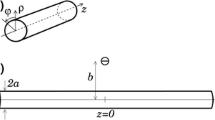Abstract
We present a novel theory and computational algorithm for modeling electrical stimulation of nerve fibers in three dimensions. Our approach uses singular perturbation to separate the full 3D boundary value problem into a set of 2D “transverse” problems coupled with a 1D “longitudinal” problem. The resulting asymptotic model contains not one but two activating functions (AF): the longitudinal AF that drives the slow development of the mean transmembrane potential and the transverse AF that drives the rapid polarization of the fiber in the transverse direction. The asymptotic model is implemented for a prototype 3D cylindrical fiber with a passive membrane in an isotropic extracellular region. The validity of this approach is tested by comparing the numerical solution of the asymptotic model to the analytical solutions. The results show that the asymptotic model predicts steady-state transmembrane potential directly under the electrodes with the root mean square error of 0.539 mV, i.e., 1.04% of the maximum transmembrane potential. Thus, this work has created a computationally efficient algorithm that facilitates studies of the complete spatiotemporal dynamics of nerve fibers in three dimensions.





Similar content being viewed by others
References
Altman KW, Plonsey R (1988) Development of a model for point source electric fibre bundle stimulation. Med Biol Eng Comput 26:466–475
Basser PJ (1993) Cable equation for a myelinated axon derived from its microstructure. Med Biol Eng Comput 31:S87–S92
Brette R, Rudolph M, Carnevale T, Hines M, Beeman D, Bower JM, Diesmann M, Morrison A, Goodman PH, Harris FC Jr, Zirpe M, Natschlger T, Pecevski D, Ermentrout B, Djurfeldt M, Lansner A, Rochel O, Vieville T, Muller E, Davison AP, Boustani SE, Destexhe A (2007) Simulation of networks of spiking neurons: a review of tools and strategies. Comput Neurosci 23:349–398
Clark J, Plonsey R (1966) A mathematical evaluation of the core conductor model. Biophys J 6:95–112
Crank J, Nicolson P (1947) Practical method for numerical evaluation of solutions of partial differential equations of the heat conduction type. Proc Camb Phil Soc 43:50–67
Dahlquist G, Björck A (1974) Numerical Methods. Prentice-Hall, Englewood Cliffs
Dixon C (1971) Applied mathematics of science and engineering. Wiley, New York
Greenberg RJ, Velte TJ, Humayun MS, Scarlatis GN, De Juan E Jr (1999) A computational model of electrical stimulation of the retinal ganglion cell. IEEE Trans Biomed Eng 46:505–514
Grill W, Kirsch R (2000) Neuroprosthetic applications of electrical stimulation. Assist Technol 12:6–20
Hinch EJ (1991) Perturbation methods. Cambridge University Press, Cambridge, UK
Hodgkin AL, Rushton WAH (1946) The electrical constants of a crustacean nerve fibre. Proc Roy Soc B 133:444–479
Holsheimer J (1998) Computer modelling of spinal cord stimulation and its contribution to therapeutic efficacy. Spinal Cord 36:531–540
Joshi RP, Song J (2010) Model analysis of electric fields induced by high-voltage pulsing in cylindrical nerves. IEEE Trans Plasma Sci 38:2894–2900
Joucla S, Yvert B (2009) The “mirror” estimate: an intuitive predictor of membrane polarization during extracellular stimulation. Biophys J 96:3495–3508
Krassowska W, Neu JC (1994) Response of a single cell to an external electric field. Biophys J 66:1768–1776
Leon LJ, Hogues H, Roberge FA (1993) A model study of extracellular stimulation of cardiac cells. IEEE Trans Biomed Eng 40:1307–1319
Lopreore CL, Bartol TM, Coggan JS, Keller DX, Sosinsky GE, Ellisman MH, Sejnowski TJ (2008) Computational modeling of three-dimensional electrodiffusion in biological systems: application to the node of Ranvier. Biophys J 95:2624–2635
Mahnam A, Hashemi SMR, Grill WM (2008) Computational evaluation of methods for measuring the spatial extent of neural activation. J Neurosci Methods 173:153–164
Mclntyre CC, Miocinovic S, Butson CR (2007) Computational analysis of deep brain stimulation. Expert Rev Med Devices 4:615–622
McNeal DR (1976) Analysis of a model for excitation of myelinated nerve. IEEE Trans Biomed Eng 23:329–337
Miranda P, Correia L, Salvador R, Basser P (2007) Tissue heterogeneity as a mechanism for localized neural stimulation by applied electric fields. Phys Med Biol 52:5603–5617
Neu JC, Krassowska W (1993) Homogenization of syncytial tissues. Crit Rev Biomed Eng 21:137–199
Pickard W (1968) A contribution to the electromagnetic theory of the unmyelinated axon. Math Biosc 2:111–121
Pucihar G, Miklavčič D, Kotnik T (2009) A time-dependent numerical model of transmembrane voltage inducement and electroporation of irregularly shaped cells. IEEE Trans Biomed Eng 56:1491–1501
Rattay F (1986) Analysis of models for external stimulation of axons. IEEE Trans Biomed Eng 33:974–977
Rattay F, Resatz S, Lutter P, Minassian K, Jilge B, Dimitrijevic M (2003) Mechanisms of electrical stimulation with neural prostheses. Neuromodulation 6:42–56
Roth BJ (1994) Mechanisms for electrical stimulation of excitable tissue. Crit Rev Biomed Eng 22:253–305
Ruohonen J, Panizza M, Nilsson J, Ravazzani P, Grandori F, Tognola G (1996) Transverse-field activation mechanism in magnetic stimulation of peripheral nerves. Electroencephalogr Clin Neurophysiol 101:167–174
Rutten W (2002) Selective electrical interfaces with the nervous system. Annu Rev Biomed Eng 4:407–452
Schnabel V, Struijk JJ (2001) Evaluation of the cable model for electrical stimulation of unmyelinated nerve fibers. IEEE Trans Biomed Eng 48:1027–1033
Stewart DA, Gowrishankar TR, Weaver JC (2004) Transport lattice approach to describing cell electroporation: use of a local asymptotic model. IEEE Trans Plasma Sci 32:1696–1708
Wang Y, Shen Q, Jiang D (2001) A modified cable function for represent the excitation of peripheral nerves by transverse field induced by pulsed magnetic field. In: Proceedings of the 23rd annual EMBS international conference, Istanbul, Turkey, October 25–26, pp 896–898
Wikswo JP Jr, Lin SF, Abbas RA (1995) Virtual electrodes in cardiac tissue: a common mechanism for anodal and cathodal stimulation. Biophys J 69:2195–2210
Ying W, Henriquez CS (2007) Hybrid finite element method for describing the electrical response of biological cells to applied fields. IEEE Trans Biomed Eng 54:611–620
Author information
Authors and Affiliations
Corresponding author
Electronic supplementary material
Below is the link to the electronic supplementary material.
Rights and permissions
About this article
Cite this article
Cranford, J.P., Kim, B.J. & Krassowska Neu, W. Asymptotic model of electrical stimulation of nerve fibers. Med Biol Eng Comput 50, 243–251 (2012). https://doi.org/10.1007/s11517-012-0870-3
Received:
Accepted:
Published:
Issue Date:
DOI: https://doi.org/10.1007/s11517-012-0870-3




